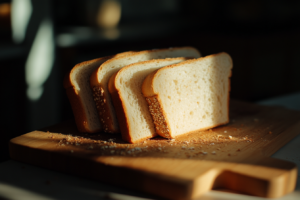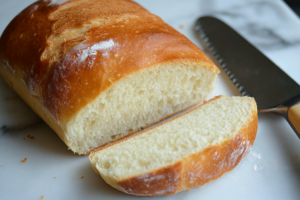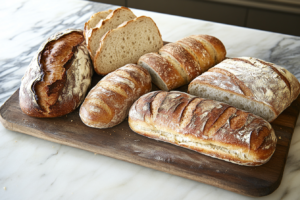Introduction
When it comes to crafting the perfect sandwich, the bread you choose plays an essential role. From classic white bread to flavorful sourdough, the choice can elevate the taste, texture, and overall experience of every bite. Each type of bread brings its own personality and flavor profile, so understanding the qualities of each can help you create sandwiches that suit your personal preferences and nutritional needs. This guide breaks down the best bread types for different kinds of sandwiches, pairing options, tips for selection, and even a few frequently asked questions. Let’s explore what makes a bread ideal for sandwiches and how to pick the perfect match for your favorite fillings.
Part 1: What is the Best Bread to Use for a Sandwich?
What Makes a Bread Ideal for Sandwiches?
When we think about the “best bread” for a sandwich, it really boils down to texture, durability, and flavor. While you might want a softer bread for a light, delicate sandwich, a more sturdy option is essential if you’re stacking on hearty fillings. The bread’s flavor, from mild to robust, should also complement rather than overpower the other ingredients.
Some key factors to consider include:
- Texture: A crusty loaf may be delicious, but too tough a crust can make it challenging to bite into a sandwich. Softer breads like white bread are generally a good fit for simpler sandwiches, while firmer options like rye hold up well with heavier ingredients.
- Density and Structure: Bread with a tighter crumb structure, like whole grain bread, tends to hold moist fillings without falling apart. This can make a big difference when you’re creating sandwiches that include juicy or layered ingredients.
- Flavor Profile: Different breads bring distinct flavors. A mildly sweet or slightly sour bread can enhance savory fillings, while a whole grain bread might add an earthy tone that complements veggies and lean proteins.
Common Types of Sandwich Breads
In sandwich-making, there are a few bread types that have stood the test of time. Here’s a brief overview:
- White Bread: Soft and versatile, white bread works well with classic sandwiches like peanut butter and jelly or simple ham and cheese. Its mild flavor is appealing for picky eaters and doesn’t overshadow the fillings.
- Whole Wheat Bread: Nutty and wholesome, whole wheat bread is often considered the healthiest bread choice for sandwiches. It’s great for veggie or turkey sandwiches, adding a bit of fiber and flavor to every bite.
- Sourdough Bread: Known for its tangy taste and firm crust, sourdough is a go-to for grilled cheese and other hot sandwiches. Its dense texture makes it suitable for heartier fillings, providing that desired “crunch” when toasted.
These foundational breads offer diverse qualities that can cater to nearly any type of sandwich, whether you’re craving something classic or unique.
Part 2: Types of Bread for Different Sandwiches
The best bread for sandwiches isn’t just about flavor – it’s about finding the right balance of texture, structure, and taste to suit your ingredients. Different sandwiches call for different breads, and in this part, we’ll dive into some classic choices and specialty options that can truly enhance your sandwich experience.
Classic Sandwich Breads
Some breads are timeless classics in the sandwich world. These types are versatile, popular, and can be paired with various fillings. Let’s explore the most iconic choices:
White Bread
White bread might be the first that comes to mind when thinking about sandwiches. It’s soft, slightly sweet, and incredibly versatile. White bread pairs well with simple fillings like peanut butter and jelly, ham and cheese, and even egg salad. Its mild flavor doesn’t compete with the ingredients, allowing them to shine.
Plus, white bread is often enriched with vitamins and minerals, making it a popular choice for everyday sandwiches. However, it’s generally not the best option for heavier or wetter fillings, as it lacks the density needed to stay intact.
Whole Wheat Bread

For a more nutritious choice, whole wheat bread is a fantastic option. Its denser, earthy taste works well with healthier sandwich options, like turkey and veggies or even chicken salad. Whole wheat bread is also high in fiber, which can make your sandwich more filling.
Due to its sturdy texture, whole wheat bread is perfect for those hearty sandwiches you can pack with layers of veggies and meats without worrying about it becoming soggy.
Sourdough Bread

Sourdough brings a unique flavor to sandwiches – its slightly sour taste and chewy texture make it a standout option. This bread is ideal for grilled cheese, where its crunchy crust can add to the sensory experience, as well as for open-faced sandwiches with ingredients that need support.
Since sourdough has a denser structure, it holds up well with rich fillings, like roast beef or pastrami, and is delightful when toasted or grilled. For sandwich lovers seeking a twist on tradition, sourdough offers a satisfying, tangy alternative to more neutral breads.
Specialty Breads for Unique Sandwich Experiences
When you’re looking to add some variety or create a more gourmet sandwich, specialty breads can elevate your creation. Let’s explore some options that bring distinct flavors and textures to the table.
Rye Bread
Rye bread, known for its dark color and robust taste, is a staple for classic sandwiches like the Reuben. The earthy flavor pairs wonderfully with meat-based fillings, especially cured meats like pastrami or corned beef. The density and firmness of rye help it hold up against these heavy ingredients, making it a go-to for those who crave a bold-tasting sandwich.
Rye bread’s distinct flavor profile isn’t for everyone, but for those who love it, it brings an unmistakable richness that’s hard to beat. It’s an ideal option when you want to add depth to your sandwich.
Ciabatta Bread
Ciabatta bread has a slightly crispy crust and an airy interior that makes it a popular choice for Italian-inspired sandwiches. Known for its rustic appearance, ciabatta can absorb oils and sauces well without getting soggy, making it perfect for paninis or sandwiches with juicy fillings.
This bread’s open structure also means it’s great for hot sandwiches. When pressed or toasted, ciabatta becomes delightfully crisp on the outside while remaining soft inside, creating a perfect vessel for ingredients like grilled vegetables, mozzarella, and Italian meats.
Focaccia
Focaccia is a thick, Italian flatbread that’s often seasoned with herbs, olive oil, and sometimes even cheese. Its flavor is rich and savory, making it perfect for gourmet sandwiches or as a base for open-faced sandwiches.
The texture of focaccia is dense yet soft, providing a great foundation for sandwiches with bold flavors, such as grilled vegetables, marinated chicken, or cured meats. Since it’s already infused with flavor, it can enhance the taste of simple ingredients, giving even a basic sandwich a gourmet feel.
Gluten-Free and Alternative Options
For those with dietary restrictions or preferences, there are plenty of alternatives that can still satisfy your sandwich cravings.
Gluten-Free Bread
If you’re gluten intolerant or have celiac disease, gluten-free bread options are more accessible and varied than ever. Made from grains like rice, tapioca, or potato flour, gluten-free breads offer a similar texture and taste to traditional bread. However, due to their ingredients, some varieties might be a bit denser or have a slightly different flavor.
Many brands offer sandwich-friendly gluten-free bread that can hold up well with fillings, making it easier than ever to enjoy your favorite sandwiches without compromising on texture or taste.
Lettuce Wraps and Other Alternatives
For a low-carb or lighter alternative, you can swap out bread entirely for options like lettuce wraps or even collard greens. These wraps offer a fresh, crunchy texture and allow the fillings to shine. Lettuce wraps are perfect for anyone looking to cut down on carbs without sacrificing the satisfying sandwich experience.
While they don’t provide the same heft as bread, these alternatives are ideal for wraps filled with lean meats, crunchy vegetables, and light sauces.
Part 3: Pairing Bread with Sandwich Fillings
Finding the perfect bread for each sandwich type can make a huge difference. The right bread not only enhances flavor but also ensures your sandwich holds up until the last bite. This section explores how to pair bread based on texture, durability, and flavor.
Choosing Bread Based on Texture and Durability
Each bread type offers a unique texture and level of sturdiness. Knowing these qualities helps you select a bread that complements your fillings without overpowering them.
- Soft Breads for Delicate Fillings: Softer breads like white bread or brioche are ideal for light fillings, like egg salad or cream cheese and cucumber. These breads are gentle on the palate, letting subtle flavors shine. However, their low density can make them prone to absorbing moisture, so they work best with drier fillings.
- Sturdy Breads for Heavy Fillings: For robust, juicy fillings like grilled vegetables, steak, or saucy pulled pork, choose sturdy bread. Breads like sourdough, rye, and ciabatta are excellent options. Their dense structure keeps them from getting soggy. Ciabatta, with its airy pockets, handles juicy fillings well, making it great for paninis or sandwiches with heavier toppings.
- Multi-layer Sandwiches and Stackable Breads: Multi-layer sandwiches need a solid base to support all layers. Whole grain bread, with its tight crumb and mild flavor, works well for layered sandwiches. Rye bread also does the job, offering a sturdy texture and rich, earthy taste.
Flavor Pairings: Enhancing Taste with the Right Bread
The flavors in your sandwich should work in harmony. Here’s how to pair bread flavors with fillings to get the best out of both.
- Rye and Bold Flavors: The strong taste of rye bread pairs beautifully with cured meats, like pastrami or corned beef. Rye’s earthy flavor balances the saltiness of these meats, creating a flavorful bite. Adding mustard or sauerkraut can elevate the contrast even more.

- Sourdough and Tangy Fillings: The mildly sour taste of sourdough bread complements tangy fillings, like sharp cheddar cheese or pickled vegetables. Sourdough’s chewy texture works well with roasted vegetables and herby spreads. Whether toasted or untoasted, it adds a twist to savory combinations that would otherwise feel plain on neutral bread.
- Whole Wheat with Lean Proteins and Fresh Veggies: Whole wheat bread is versatile and healthy, pairing well with fresh ingredients. The slightly nutty taste of whole wheat bread enhances lean proteins like turkey or chicken breast. It also adds a rustic flavor that works well with light, veggie-focused fillings.
- White Bread and Classic Flavors: For simple, nostalgic sandwiches, white bread is ideal. Its mild flavor suits classic combinations like ham and cheese, peanut butter and jelly, or egg salad. White bread lets the fillings take center stage, adding enough softness and structure for an enjoyable sandwich.
With these pairing tips, you can create sandwiches that aren’t just filling but also balanced in flavor and texture.
Part 4: Tips for Selecting the Best Bread for Sandwiches
Choosing the right bread can be a game-changer for your sandwich-making. Beyond flavor and texture, there are a few insider tips that can help you pick the perfect loaf every time. Here’s what to keep in mind when shopping for or selecting bread for sandwiches.
Freshness Matters
Fresh bread is essential for a great sandwich. Stale bread can make even the best fillings taste dull, so always aim for fresh options. If you’re buying bread from a bakery, ask when it was baked. Many bakeries bake daily, which means you’re likely getting bread that’s only hours old. If you’re buying packaged bread, check the date. Fresher bread not only tastes better but also holds up well with fillings.
Factors to Consider: Texture, Crust, and Moisture
The best bread for a sandwich isn’t just about taste; it’s about texture, crust, and moisture level.
- Texture: Some sandwiches call for softer, pillowy bread, while others need something with a bit more chew. Think about the type of fillings you’ll use. Soft, airy bread works best for light fillings, while denser bread suits heavy or saucy ingredients.
- Crust: Crustier bread, like baguettes or sourdough, can add a satisfying crunch. However, if the crust is too hard, it can make the sandwich tough to eat. For an easy-biting sandwich, go with bread that has a softer crust, like whole wheat or white bread.
- Moisture: Bread with a bit of moisture – not overly dry – tends to hold up better, especially for sandwiches with spreads or juicy fillings. Dry bread can turn crumbly, which isn’t ideal when you’re layering on ingredients. If you want the bread to absorb a bit of moisture (like with olive oil or sauce), go for options like ciabatta or focaccia, which soak up flavors without getting mushy.
By considering these elements, you’ll find bread that complements your sandwich ingredients perfectly.
Part 5: Frequently Asked Questions about the Best Bread for Sandwiches
Curious about which breads are healthiest, or wondering if gluten-free options work well for sandwiches? Here are answers to some common questions about choosing the best bread for sandwiches.
What is the Healthiest Bread for Sandwiches?
For a health-conscious option, whole grain bread is often a top choice. Whole grains contain fiber, protein, and essential nutrients, making them more filling and nutritious than white bread. Other healthy options include sprouted grain bread, which can be easier to digest, and rye bread, which is lower on the glycemic index.
If you’re looking for a low-carb option, some people enjoy using lettuce wraps as a bread substitute. While it lacks the grain content of traditional bread, it’s a fresh, low-calorie alternative.
Can I Use Gluten-Free Bread for Sandwiches?
Yes! Gluten-free bread is a great option for those with gluten sensitivities or celiac disease. Made from ingredients like rice flour, potato starch, or tapioca flour, gluten-free bread has come a long way in texture and taste. While some brands might be denser than traditional bread, many hold up well with fillings, allowing you to enjoy a satisfying sandwich without gluten.
Which Bread is Best for Cold vs. Hot Sandwiches?
Some breads are better suited to cold sandwiches, while others shine when heated. For cold sandwiches, softer breads like white or whole wheat are ideal because they’re easy to bite into without heating. On the other hand, denser breads like ciabatta, sourdough, and focaccia are perfect for hot sandwiches like paninis or grilled cheese. These breads can withstand high temperatures without losing structure, making them ideal for toasting or pressing.
Are There Vegan-Friendly Sandwich Bread Options?
Absolutely! Most breads are vegan-friendly, but it’s always wise to check the ingredients list. Common vegan bread types include whole grain, sourdough, and rye bread. However, some varieties, like brioche or enriched white bread, may contain dairy or eggs, so look for labels marked vegan if you’re unsure.
By considering these FAQs, you can make more informed choices about the best bread for your dietary needs and sandwich preferences.
Part 6: Conclusion: Choosing Your Ideal Bread for the Perfect Sandwich
Selecting the right bread can transform a simple sandwich into a memorable meal. From classic options like white and whole wheat to bold choices like rye and sourdough, each type of bread brings its own texture, flavor, and durability to the table. By understanding how to pair different bread types with specific fillings, you can create sandwiches that are not only delicious but also hold up well and are enjoyable to eat.
Whether you’re making a light veggie sandwich, a hearty meat-stacked creation, or a gourmet-inspired panini, there’s a perfect bread out there to complement every ingredient. Experiment with different types, consider the textures, and don’t shy away from exploring specialty breads to add a unique twist.
Ultimately, the best bread for sandwiches is the one that brings out the flavors you love, provides the right texture, and makes your sandwich truly satisfying. So, the next time you’re crafting a sandwich, remember: the bread is just as important as what’s inside. Happy sandwich-making!


1 thought on “What is the Best Bread to Use for a Sandwich?”